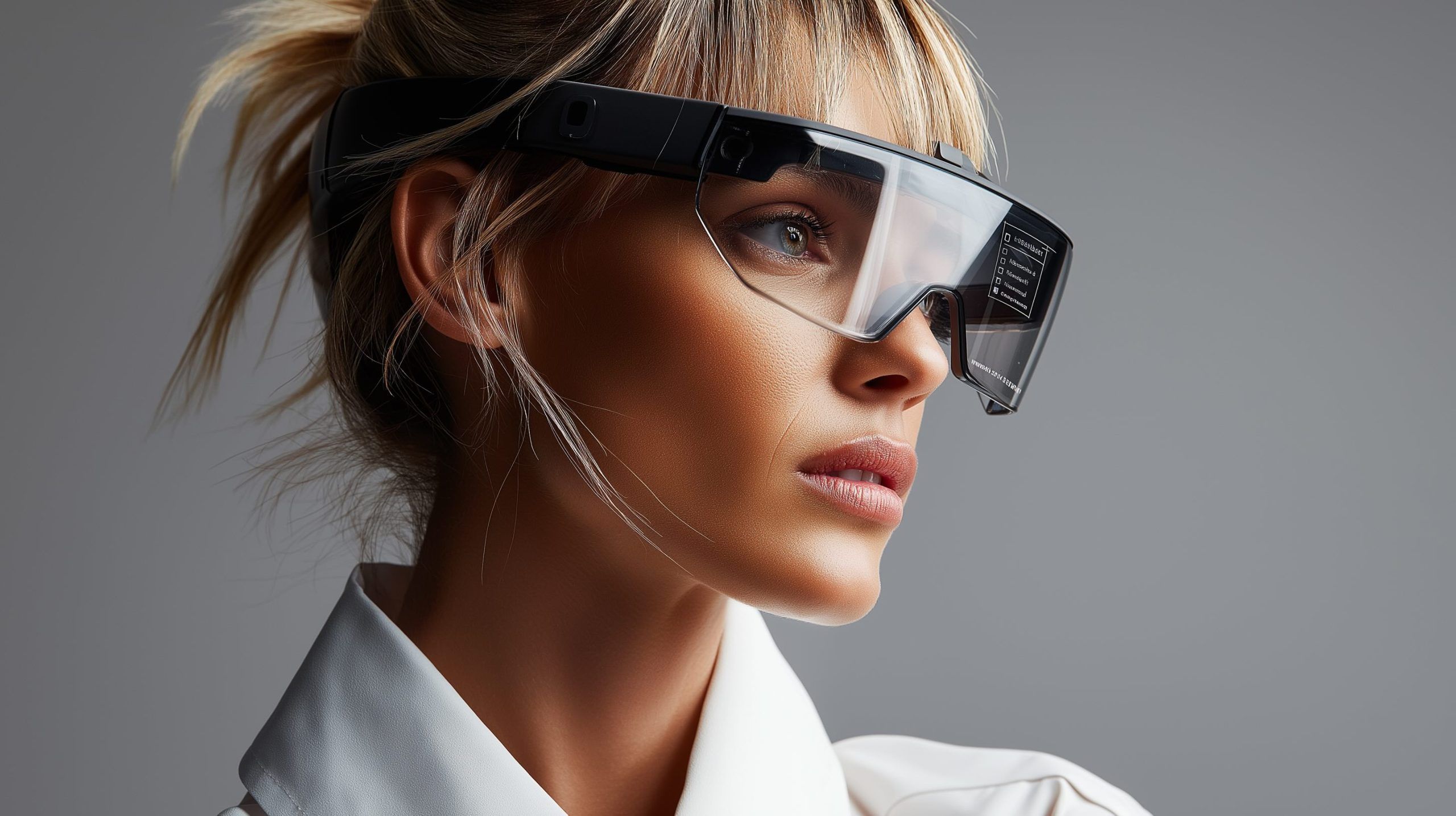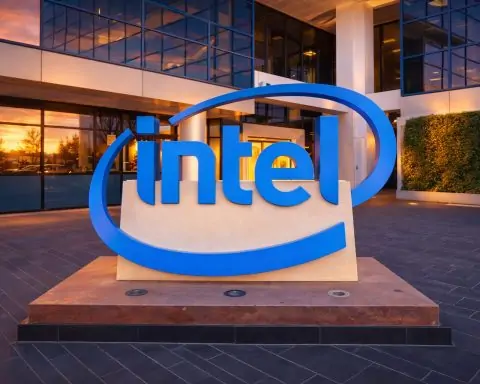- HTC unveiled the VIVE Eagle AI Glasses, a lightweight under-50g device priced around $520 with 4.5-hour battery life, launching first in Taiwan with local carrier partnerships.
- Vuzix announced the LX1 Smart Glasses for warehouse and logistics use, featuring a hot-swappable 7,000mAh battery for 10-hour shifts, a Sony OLED HD display, voice controls, and an integrated scanner powered by a Qualcomm XR chipset.
- DPVR launched the P1 Max enterprise VR headset, built on the P1 Pro 4K with an active ventilation system delivering 50% better thermal efficiency, a 24/7 top-mounted power interface, and Snapdragon XR2 for 8K decoding, with global shipments beginning in August 2025.
- Samsung teased its XR headset codenamed “Moohan” at Galaxy Unpacked, signaling a re-entry into VR/AR in partnership with Google and Qualcomm.
- Varjo demonstrated its XR-4 mixed reality headset with a full F/A-18 fighter jet simulator installed at its Helsinki HQ by Dogfight Boss.
- Microsoft announced Immersive Events in Teams, enabling 3D avatars and virtual meeting spaces via Microsoft Mesh in public preview.
- Basemark released Rocksolid AR Studio v25.3, adding Gemini GPT AI assistant, Google Maps API, a Virtual Cockpit mode, Android Automotive 14 support, and support for custom C++ modules.
- Burnley FC and Rezzil streamed Burnley’s Aug 9 preseason friendly against Lazio in VR on Quest via the Premier League Player app, delivering 180° stadium views from a virtual Turf Moor.
- Switzerland launched Swiss Safety VR in partnership between Suva and BearingPoint, offering free Quest-based workplace safety training to companies and schools in multiple languages.
- Red 6 partnered with Northrop Grumman to integrate its ATARS AR system into Northrop’s Beacon autonomous aircraft testbed for mixed human/AI pilot training.
August 2025 was a breakout month for virtual and augmented reality (XR), packed with headline-grabbing launches and initiatives across hardware, software, enterprise, and entertainment. Tech giants and startups alike rolled out new VR headsets and AR smart glasses, while industry partnerships brought immersive tech into workplaces, defense, healthcare, and even Premier League football. Below is a comprehensive roundup of the month’s major XR developments – from cutting-edge gadgets and apps to market trends, funding news, community updates, and how VR is bringing live sports to fans. (Spoiler: One English club just let supporters watch a match from a virtual stadium seat.)
Major Product Launches & Hardware Announcements
Several high-profile XR devices debuted in August, signaling rapid innovation in both VR and AR hardware:
- HTC VIVE Eagle AI Glasses – HTC unveiled VIVE Eagle, a lightweight (<50g) pair of smart glasses that combine music playback, photography, and an AI voice assistant with real-time translation in 13 languages [1] [2]. “VIVE Eagle represents HTC’s newest exploration in intelligent living…smart technology that fits naturally into everyday life,” said HTC SVP Charles Huang [3]. Priced around $520, it launches first in Taiwan with local carrier partnerships and promises 4.5-hour battery life with fast charging [4] [5].
- Vuzix LX1 Smart Glasses – AR veteran Vuzix announced the LX1, a rugged, hands-free wearable display tailored for warehouse and logistics workers [6]. It boasts a hot-swappable 7,000mAh battery for 10-hour shifts, a heads-up Sony OLED HD display, voice controls, and an integrated scanner, all powered by a Qualcomm XR chipset [7]. “We are delighted to be powering Vuzix LX1 smart glasses,” noted Qualcomm XR GM Ziad Asghar, underscoring Qualcomm’s belief in the enterprise smart glasses segment [8]. Vuzix CEO Paul Travers added that LX1’s simple, fast operation makes it “the ideal next-generation picking device” for supply chain customers, with early feedback “excellent” as it heads into production by year-end [9] [10].
- DPVR P1 Max VR Headset – Shanghai-based DPVR launched the P1 Max, its latest enterprise VR headset built on the prior P1 Pro 4K, now with substantially upgraded performance and cooling [11]. Key features include an active ventilation system (50% better thermal efficiency), a top-mounted power interface for 24/7 use in arcades and training sims, and Qualcomm’s Snapdragon XR2 chip enabling 8K video decoding [12]. The headset also offers a USB-C expansion port for add-ons like eye tracking [13]. “The P1 Max represents our commitment to continuously evolving with the needs of business customers,” said DPVR COO Derek Liu, promising stability, performance and adaptability for everything from “power-hungry simulations to multi-user education setups” [14]. Global enterprise shipments began in August.
- Samsung “Moohan” Teaser – At its summer product event, Samsung finally teased its long-rumored XR headset (code-named “Moohan”) after a long period of silence [15]. While details remained scarce, the confirmation at Galaxy Unpacked signaled Samsung’s re-entry into the VR/AR race in partnership with Google and Qualcomm. Observers are watching closely to see if Samsung’s device will “move the needle for business-ready VR” as promised [16].
- Varjo XR-4 Fighter Simulator Demo – High-end XR company Varjo didn’t launch a new headset this month, but it did showcase the prowess of its XR-4 mixed reality headset by installing a full F/A-18 fighter jet simulator at its Helsinki HQ [17]. Built by Dogfight Boss, the replica cockpit integrates with Varjo’s XR headset for hyper-realistic flight training with physical controls. “Everything the pilot touches, sees, or interacts with is spot on,” said Dogfight Boss CEO Lukas Homola of the immersive sim [18]. The system aligns a virtual sky over real switches and dials, using force-feedback and haptics to mimic the rumble of gear deployments and missile releases [19] [20]. This demo underscores how cutting-edge hardware and peripherals are combining to blur the line between simulation and reality.
New Software Platforms, Apps, and Games
On the software side, August saw notable updates and content launches spanning enterprise AR development, collaboration tools, and VR gaming:
- Basemark’s AR Platform Upgrade – Finnish software firm Basemark released Rocksolid AR Studio v25.3, a major update to its low-code automotive AR development platform [21]. The new version adds AI assistant integration (Gemini GPT) and Google Maps API support for location-aware features, plus a “Virtual Cockpit” mode to design AR interfaces across multiple in-car displays simultaneously [22]. Developers can also now plug in custom C++ modules via a unified API, and Android Automotive 14 support is included for easier car system integration [23] [24]. “We’re seeing strong momentum for automotive AR and now applying our tech to defense, field ops, and manufacturing,” said Basemark CEO Tero Sarkkinen. With this update, they are “enhancing in-vehicle applications with AI, mapping, and multi-display capabilities to deliver key information to drivers exactly when and where it’s needed” [25].
- Immersive Meetings in Microsoft Teams – Workplace collaboration in XR got a boost as Microsoft debuted “Immersive Events” in Teams as a public preview [26]. This feature enables 3D avatars and virtual meeting spaces through Microsoft Mesh, allowing colleagues to join Teams sessions in mixed reality. The early rollout suggests Microsoft’s continued investment in enterprise XR software, following its prior Mesh for Teams demos. As more companies explore hybrid work, integrated solutions like this could make VR meetings more commonplace.
- VR Gaming Showcase and Releases – In mid-August, a dedicated VR Games Showcase (live-streamed on August 12) revealed fresh titles coming to Meta Quest, PlayStation VR2, and PC VR [27]. Among the highlights were Hidden Memories of the Gardens Between (a whimsical time-manipulation puzzle adventure) and World War Z VR (a co-op zombie shooter reimagined in first-person) set for release on major VR platforms [28]. While summer is typically quiet for game launches, VR enthusiasts still saw a few notable releases: for example, Don’t Move (a darkly humorous motion-sensitive challenge) hit Steam on Aug 14, and Grit and Valor: 1949 (a tactical mech combat roguelite) landed on all headsets by Aug 21 [29] [30]. These titles – alongside new peripherals like haptic vests and VR treadmills showcased by third-parties – indicate that the VR gaming ecosystem continues to mature with a steady drumbeat of content and accessories.
Enterprise and Industrial XR Use Cases
Real-world enterprise deployments of XR accelerated in August, with organizations adopting VR/AR for training, safety, healthcare, and more:
- Workplace Safety Training: Switzerland’s national accident insurer Suva partnered with consultancy BearingPoint to launch “Swiss Safety VR,” an immersive training platform aimed at reducing jobsite accidents [31]. The VR simulations let workers practice securing heavy loads or preventing falls in a risk-free virtual environment, illustrating the real consequences of unsafe practices. “Together with Suva, we are using virtual reality to deliver practical and effective workplace safety training,” said Matthias Roeser of BearingPoint, noting the program makes training “more engaging, more impactful, and more scalable.” [32] Importantly, Suva is offering the Quest-based program free of charge to companies and even schools across Switzerland (in multiple languages) to democratize access to life-saving training [33].
- Skilled Trades & Energy: In the energy sector, VR Vision (Toronto) teamed with Enel Green Power to develop VR training simulations for renewable energy technicians [34]. These realistic 3D scenarios create digital twins of wind turbines, solar farms, and substations, allowing techs to practice maintenance procedures and emergency responses in VR. The goals: improve safety, speed up onboarding, and standardize training across Enel’s global operations [35] [36]. “Virtual reality is revolutionizing how the energy sector trains its workforce,” said VR Vision CEO Roni Cerga, delivering “immersive, scalable, and results-driven training experiences that drive real operational impact.” [37] Similarly, UK-based Rezzil, known for VR sports training, expanded into fan engagement (more on that later) but is also backed by a Premier League partner to use its VR simulation tech in professional soccer training [38] – showing XR’s range from vocational training to athletic performance.
- Healthcare & Medicine: The Government of Canada announced that Saskatchewan’s Virtual Health Hub is joining the federal CAN Health Network to deploy new digital tools for rural care [39]. As part of this, local startup Luxsonic will provide a VR platform to enable remote radiology diagnosis in VR headsets, effectively virtualizing medical imaging for far-flung communities [40]. Luxsonic’s Health Canada-approved system creates an immersive radiology workspace – replacing physical lightboards and 2D scans with a VR environment where doctors can view and collaborate on high-definition 3D medical images in real time [41]. This can dramatically improve specialist access for remote hospitals. Canadian officials praised the initiative, noting it supports homegrown innovation and “helps patients get better care closer to home” [42]. Meanwhile, in the U.S., senior care is embracing VR: startup Rendever launched a new VR dementia empathy training program for caregivers, using interactive scenarios and an AI guide to let health workers experience the world through the eyes of a person with dementia [43] [44]. The program, deployed in senior living organizations, builds empathy by simulating symptoms like cognitive decline and hallucinations. “Empathy is much more than a buzzword; it’s fundamental to care,” said Rendever CEO Kyle Rand. This VR training gives staff “an accessible, hands-on experience to understand the symptomology of dementia and provide better care centered on empathy.” [45] Early feedback is positive, and Rendever notes families of patients can also use it to better understand their loved ones’ challenges [46].
- Defense & Aerospace: The military continued to invest in XR for training and R&D. Florida-based Red 6 – a firm specializing in augmented reality fighter pilot training – announced a partnership with defense giant Northrop Grumman to integrate Red 6’s ATARS AR system into Northrop’s Beacon autonomous aircraft testbed [47]. The ATARS tech projects realistic virtual enemies and mission scenarios into real skies for pilots wearing custom AR visors, enabling live dogfight training against AI “bogeys” without real opposing jets. By joining Northrop’s open testbed, Red 6 can help develop tactics for mixed human/AI air combat and next-gen autonomous wingmen [48]. “The Beacon program represents the future of autonomous mission development, and we’re excited to contribute Red 6’s innovative AR capabilities to this initiative,” said Red 6 founder Daniel Robinson [49]. The U.S. Air Force (which has trialed Red 6) is interested in such systems to improve safety, reduce cost, and push the envelope of pilot training. And in Finland, as noted, Varjo’s mixed reality flight simulator demo with Dogfight Boss has been turning heads, showing how ultra-high-fidelity XR can be used for mission rehearsal, R&D, and even testing new cockpit interfaces with incredible realism [50] [51].
Partnerships, Mergers & Acquisitions in XR
August featured many strategic partnerships in the XR industry, underscoring a trend of collaboration (with little in the way of blockbuster M&A this month). Noteworthy alliances included:
- BearingPoint × Suva (Switzerland): Consulting firm BearingPoint and insurer Suva co-developed the Swiss Safety VR training platform to tackle construction accidents, as described above [52]. By co-investing in XR content and rolling it out nationwide (free for users), this public-private partnership aims to make VR safety training a standard in Swiss industry [53].
- VR Vision × Enel Green Power: VR Vision’s deal with Enel created a global VR training program for renewable energy workers – a prime example of an XR startup teaming with an energy multinational to modernize workforce development [54] [55]. The partnership leverages each side’s strengths (VR Vision’s tech and Enel’s industry domain) to deliver scalable, “safety-first” training simulations for wind, solar, and electrical grid operations across dozens of countries.
- Red 6 × Northrop Grumman: An AR innovator joining forces with a top defense contractor brings credibility (and resources) to both. By integrating Red 6’s combat AR into Northrop’s Beacon platform, the two will co-develop next-gen pilot training modules that could be adopted across the U.S. and allied air forces [56] [57]. Northrop’s VP Tom Jones lauded Beacon’s open ecosystem approach: “By providing open access to the Beacon ecosystem, we’re enhancing the innovation… and ultimately the autonomous capabilities that industry can deliver to our customers – with unmatched speed and at scale.” [58]
- Burnley FC × Rezzil: In sports, English Premier League club Burnley extended its partnership with VR training firm Rezzil to venture into fan engagement via VR [59]. (See the entertainment section below for details on the VR match streaming experience this produced.) This crossover collaboration shows traditional sports organizations actively experimenting with XR to reach global fans in new ways.
- PICO × Blender: On the developer tools front, headset maker PICO (ByteDance) announced a partnership with the Blender Foundation in late July (carrying into August) to support Blender’s OpenXR initiatives [60]. By becoming an official contributor, PICO aims to streamline 3D content creation pipelines for XR and ensure cross-platform compatibility. Jessie Zhang, PICO’s Head of Partnerships, said the goal is to “enhance 3D creation tools” and “foster a community where every artist and developer can bring their unique immersive vision to life… through OpenXR.” [61] This kind of industry collaboration on open standards is vital for long-term ecosystem growth.
Mergers & Acquisitions: Notably, no major XR company acquisitions were announced during August 2025 – a contrast to some earlier in the year. Instead, the industry’s momentum this month came from alliances and organic product growth. (The last significant M&A was in the healthcare XR arena back in Q1, when XRHealth acquired another telehealth VR startup, but nothing of that scale hit in August.) This suggests that companies are currently focused on partnerships and internal R&D over consolidation, as the technology and market fit of XR continue to evolve.
Market Trends, Funding News & Regulatory Developments
XR Market Outlook: Market research in August painted a mixed but optimistic picture for XR adoption. According to IDC’s latest Worldwide AR/VR Headset Tracker, global headset shipments grew 18.1% year-over-year in the most recent quarter [62] – a significant rebound, with Meta’s Quest 2 and Pro leading at 50.8% market share [63]. “The worldwide AR/VR headset market is reaching a critical tipping point,” observed IDC research director Ramon Llamas [64]. However, the data hints at a shift in device preferences: “Pure VR was once the darling… Now we have it on track to wind down in the next few years.” Likewise, pure AR devices (like HoloLens) remain niche. Instead, mixed reality (MR) and smart glasses are on the rise – “the market is clearly shifting toward more immersive and versatile experiences,” said Jitesh Ubrani of IDC, noting the success of new form factors [65]. Notably, XREAL (formerly Nreal) has surged to become the second-largest XR hardware vendor, thanks to its slick AR glasses, and fellow startup Viture saw sales jump 268% year-over-year with its wearable displays [66]. In fact, IDC reports a broader move toward lightweight optical see-through AR glasses and hybrid MR headsets, especially with Apple’s Vision Pro on the horizon [67] [68]. For 2025, IDC tempered expectations – forecasting a 12% dip in total XR device shipments due to some delayed product launches – but they predict a massive 87% surge in 2026, kicking off an extended growth cycle at ~38.6% CAGR through 2029 [69] [70]. Llamas expects mixed reality to gain strong traction (especially with Apple and Android XR entrants), and sees extended reality (ER) glasses steadily expanding among consumers (e.g. for gaming) [71]. The upshot: the XR industry is maturing past its early hype, and while 2025 is a recalibration year, analysts anticipate an inflection point in 2026 as more advanced devices hit the market and enterprise use cases prove their value.
Funding and Investments: Investor interest in XR remained healthy. For example, UK-based Aircards – a developer of AR/VR experiences and interactive display installations – secured a £3 million ($3.8M) growth investment from Foresight Group to fuel its expansion [72]. The funding will help Aircards scale up its in-house production of immersive displays (like AR-enabled smart mirrors and LED “portal” installations) and further develop its Metalitix spatial analytics platform for measuring 3D content engagement [73] [74]. “With Foresight’s backing, we’re scaling our core studio, expanding our network of interactive AI and AR-enabled hardware displays, and growing the immersive software and fabrication capabilities that connect digital storytelling with impactful physical experiences,” said Aircards COO Michael Watson of the milestone [75]. The month also saw smaller funding rounds and grants in the XR space – from VR simulation firms raising seed capital to government innovation funds (like Canada’s above) earmarking budget for XR deployments. On the flip side, the crypto/NFT-fueled “metaverse” hype has cooled, so investors in 2025 are more keen on practical XR solutions (training, healthcare, enterprise tools) than on speculative virtual worlds. Overall, fresh capital is flowing into startups that demonstrate real use cases and revenue, even as some earlier-stage XR companies consolidate or pivot. Regulatory changes specific to XR were minimal in August – no major legislation or lawsuits – though broader tech regulations (privacy, AI, app store rules) will inevitably affect XR as it integrates with AI and wearables. Industry groups continue to work on standards and best practices for safety and ethics in immersive tech. Notably, IEEE’s new XR ethics guidelines and the XR Association’s lobbying in Washington are ongoing, but nothing game-changing passed into law this month. The EU is, however, mulling stricter privacy rules around AR smart glasses in public, which could surface later in 2025. For now, XR companies are largely self-policing issues like user safety, and focusing on obtaining certifications (e.g. ISO data security for HTC’s VIVE Eagle glasses [76]). Expect more attention on regulatory compliance as XR devices become more commonplace at work and in public spaces.
Developer and Community Updates
It wasn’t just products and deals – August 2025 offered glimpses of the future of XR through prototypes, research breakthroughs, and community-driven projects:
- Meta’s Prototype VR Headsets: At the SIGGRAPH 2025 conference, Meta’s Reality Labs Research showcased several next-generation VR headset prototypes, wowing attendees with what’s possible. Codenamed “Tiramisu” and “Boba 3,” the experimental headsets achieve ultra-wide 180° field-of-view visuals and near-photorealistic clarity in a compact goggle form factor [77] [78]. Together, these prototypes aim to deliver such hyper-realistic immersion that they could “pass a visual Turing test” – meaning users might not distinguish VR from reality [79]. One prototype is pure VR (using novel high-curvature reflective optics), and the other is a mixed reality device with 80 MP passthrough cameras for an equally wide AR view [80] [81]. The demos showed a dramatically expanded field compared to today’s ~100° FOV headsets – e.g. letting a user see a person sitting right next to them in VR, which current Quests cannot do [82] [83]. Researchers also managed to keep these wide-FOV devices remarkably slim, comparable in size to consumer headsets [84]. While Meta emphasized these are research-only units (many of their lab demos never reach production), the technology illustrates the direction VR hardware could go in coming years: wider view, higher realism, and blending seamlessly with physical reality [85]. It also underscores Meta’s commitment to pushing the envelope, as they race against Apple, Valve, and others to achieve truly immersive “VR 2.0” experiences.
- Meta’s AI “Dream Team” for XR: Another big move from Menlo Park – Meta aggressively hired top talent in AI to turbocharge its XR ambitions. In early August, Meta announced the formation of a new Meta Superintelligence Labs (MSL) group, having poached star researchers from OpenAI, Google DeepMind, and academia [86] [87]. This “AI dream team” includes experts like Jack Rae (architect of advanced language models at DeepMind) and others lured with compensation packages reportedly exceeding $10 million per person per year [88] [89]. The hiring spree – with costs “among the highest in tech history” – signals Meta’s bet that AI will redefine spatial computing [90]. Industry insiders noted that Meta is essentially flexing its ability to “hire basically anyone” it wants in AI [91]. By uniting world-class AI researchers with its XR hardware teams, Meta hopes to create intelligent virtual agents, generative content tools, and adaptive interfaces for its next-gen AR/VR devices. As one XR analyst put it: “The convergence of AI and spatial computing represents the most significant workplace transformation since the introduction of personal computers.” [92] Meta’s investment suggests they believe the timeline for AI-enhanced XR is accelerating. In practical terms, we may soon see features like real-time translated subtitles in VR meetings [93], AI-generated virtual environments on demand, or smart AR glasses that can understand context and proactively assist users. For developers, this opens exciting possibilities – but also a learning curve to integrate AI into XR apps. Meta’s MSL gambit indicates an emerging talent war at the intersection of AI and XR, one that could decide who leads the next era of computing.
- Open Standards & Tools: The XR developer community saw progress in tools and standards. The PICO-Blender partnership mentioned earlier is one example, aiming to make creating XR content easier via OpenXR interoperability [94]. We also saw continued adoption of the OpenXR standard itself: more engines and platforms now default to OpenXR, simplifying cross-platform VR/AR development (no new standard versions in August, but steady momentum). On the content creation side, Unity and Unreal Engine both teased upcoming features for XR devs at SIGGRAPH – such as better real-time lighting in VR and editor support for Apple’s Vision Pro – reflecting how major engines are aligning with the latest hardware. Meanwhile, Microsoft’s MR developer toolkit got an update as they prepare the next HoloLens software, and WebXR demos at SIGGRAPH showed web-based AR is getting more capable. It’s clear that developers are gaining better tools, SDKs, and open frameworks to build the immersive experiences envisioned in all the announcements above.
- Community Innovations (Burning Man VR): XR’s grassroots community also made news. Fans of Burning Man – the annual arts festival in Nevada – have for years run BRCvr, a digital Burning Man in VR. When Microsoft shut down AltspaceVR (the platform they originally used) in 2023, the community didn’t give up. In August, organizers Athena Demos and Doug Jacobson announced the beta launch of BurnerSphere, a bespoke social VR app they built from scratch to host virtual Burning Man experiences [95] [96]. After testing 40+ alternative platforms and finding none could handle their needs (huge worlds, user-generated art, no corporate influence), they decided to “go their own way” [97] [98]. BurnerSphere allows VR users (and even PC users) to explore a digital Black Rock City year-round – complete with community-contributed art installations, live event streams, and recreations of famous Burning Man landmarks [99] [100]. During the actual Burning Man 2025 event (late August), BRCvr planned to pipe in live 360° video from the desert and add new content weekly, blending real festival footage with VR environments [101] [102]. The project adheres to Burning Man’s principles (no commerce, open participation) and is funded by donations and a modest membership fee, rather than big sponsors [103] [104]. This story highlights the resilience and passion of XR communities – even when major platforms shut down, users are willing to build their own world to keep the virtual tribe together. It also underscores ongoing friction in the “metaverse” space: enthusiasts often find mainstream platforms too restrictive or risky (as they can be shuttered at any time), driving a desire for decentralized or self-hosted worlds. BurnerSphere is a gamble, as its creators admit [105], but it represents how user communities are actively shaping the metaverse on their own terms in 2025.
Consumer and Media Trends in XR Entertainment
Perhaps the biggest sign of XR’s mainstream creep in August came in the realm of sports and entertainment – where virtual and augmented reality are offering novel experiences to consumers:
- VR Comes to the Premier League: In a historic first for English football, Burnley F.C. streamed a live match in virtual reality for fans around the world [106]. Through the new “Premier League Player” VR app (developed with Meta), Quest headset owners could watch Burnley’s Aug 9 preseason friendly against Lazio from a virtual VIP seat inside a 3D model of Turf Moor stadium [107] [108]. The VR broadcast featured panoramic 180° views, real-time match commentary, and on-demand replays, creating the sense of being at the game without leaving home [109]. “This partnership with Rezzil and Premier League Player allows us to share the magic of Turf Moor in a truly immersive way,” said Burnley chairman Alan Pace, calling the move “our forward-thinking approach to fan engagement” and a commitment to give global supporters the best experiences [110]. Indeed, Burnley’s ownership has been notably tech-savvy (Pace is an American investor with a Silicon Valley background), and this experiment positions the small club as a pioneer in fan-facing VR.
- Fan Reactions and Future of Sports XR: The match was offered for free to viewers (no subscription needed) [111], essentially as a pilot demo of what VR sports could be. Initial feedback from fans was mixed – some loved the novel perspective, while others noted the graphics (virtual crowd, etc.) still felt a bit “video-gamey.” But the significance wasn’t lost on industry watchers: live sports in VR has long been discussed, and now it’s a reality. Rezzil’s co-founder Andy Etches, whose company provided the tech, said “we’re thrilled to bring fans a truly next-generation football experience… It’s a new way to watch football; it’s like having a seat in the stands.” [112] With the Premier League itself as an official partner, this could expand to more clubs and matches if successful [113]. Other leagues are surely monitoring it. (Notably, the NBA and NASCAR have dabbled in VR broadcasts in prior years, but the Premier League is the most-watched sports league globally.) Beyond sports, concert organizers and Hollywood studios are also exploring VR and AR. August saw announcements of a few upcoming VR concert experiences for the fall, and an AR promotion for an upcoming superhero movie where fans can see AR characters via their phones. While these weren’t headline items, they fit the pattern: media and entertainment companies are testing XR to engage audiences, even if at small scale.
- Consumer Adoption and Culture: Despite these advances, XR is still at an early stage with the general public. Surveys show that most consumers remain on the sidelines, often citing price, comfort, or content as barriers. However, attitudes are slowly shifting as more people get firsthand exposure to VR/AR at events, retail demos, or through friends. The involvement of household names (Meta, Apple, Microsoft) lends credibility that this tech isn’t just a fad. In fact, some tech leaders are downright bullish on the long-term ubiquity of AR. Mark Zuckerberg recently predicted that “everyone who has glasses is pretty quickly going to upgrade to smart glasses over the next decade… and a lot of other people who aren’t wearing glasses today are going to end up wearing them, too.” [114] The Meta CEO’s bold claim reflects his view that stylish AR eyewear will eventually replace today’s smartphones as our primary personal tech. We’re not there yet – current AR glasses like HTC’s Eagle or XREAL are still limited in functionality – but the trend toward wearable, always-on AR is underway. Popular culture is also reflecting XR more: VR was a plot point in a top TV series this month, and AR effects continue to explode on social media apps. All told, August 2025 showed that XR is steadily moving from tech demo to real-world use. With each month bringing new breakthroughs – be it a safer workplace, a medical lifesaver, or a mind-blowing way to watch sports – virtual and augmented reality are proving their value across every arena of life. The groundwork laid now suggests an exciting future ahead, one where immersive tech might truly become as common as the smartphones and TVs of today.
Sources:
- BearingPoint & Suva VR safety training – Auganix (Sam Sprigg) [115] [116]
- Aircards £3M funding announcement – Auganix [117] [118]
- Rendever dementia training & CEO quote – Auganix [119] [120]
- HTC VIVE Eagle launch & quote – Auganix [121] [122]
- Basemark Rocksolid AR update & CEO quote – Auganix [123] [124]
- Vuzix LX1 features & CEO quotes – Auganix [125] [126]
- DPVR P1 Max specs & quote – Auganix [127] [128]
- VR Vision & Enel training partnership – Auganix [129] [130]
- CAN Health Network & Luxsonic in VR healthcare – Auganix [131] [132]
- Varjo/Dogfight Boss XR simulator – Auganix [133] [134]
- Red 6 & Northrop AR combat training – Auganix [135] [136]
- Burnley FC & Rezzil VR match announcement – Auganix [137] [138]
- XR Today Weekly (Aug 8 & 15) – XR Today Newsletters [139] [140]
- IDC AR/VR market analysis – XR Today [141] [142]
- Meta’s AI hires (“dream team”) – XR Today [143] [144]
- Burning Man VR (BRCvr BurnerSphere) – The Verge [145] [146]
- Mark Zuckerberg quote on smart glasses – XR Today [147]
References
1. www.auganix.org, 2. www.auganix.org, 3. www.auganix.org, 4. www.auganix.org, 5. www.auganix.org, 6. www.auganix.org, 7. www.auganix.org, 8. www.auganix.org, 9. www.auganix.org, 10. www.auganix.org, 11. www.auganix.org, 12. www.auganix.org, 13. www.auganix.org, 14. www.auganix.org, 15. www.xrtoday.com, 16. www.xrtoday.com, 17. www.auganix.org, 18. www.auganix.org, 19. www.auganix.org, 20. www.auganix.org, 21. www.auganix.org, 22. www.auganix.org, 23. www.auganix.org, 24. www.auganix.org, 25. www.auganix.org, 26. www.xrtoday.com, 27. www.roadtovr.com, 28. www.uploadvr.com, 29. www.uploadvr.com, 30. www.uploadvr.com, 31. www.auganix.org, 32. www.auganix.org, 33. www.auganix.org, 34. www.auganix.org, 35. www.auganix.org, 36. www.auganix.org, 37. www.auganix.org, 38. www.xrtoday.com, 39. www.auganix.org, 40. www.auganix.org, 41. www.auganix.org, 42. www.auganix.org, 43. www.auganix.org, 44. www.auganix.org, 45. www.auganix.org, 46. www.auganix.org, 47. www.auganix.org, 48. www.auganix.org, 49. www.auganix.org, 50. www.auganix.org, 51. www.auganix.org, 52. www.auganix.org, 53. www.auganix.org, 54. www.auganix.org, 55. www.auganix.org, 56. www.auganix.org, 57. www.auganix.org, 58. www.auganix.org, 59. www.auganix.org, 60. www.xrtoday.com, 61. www.xrtoday.com, 62. www.xrtoday.com, 63. www.xrtoday.com, 64. www.xrtoday.com, 65. www.xrtoday.com, 66. www.xrtoday.com, 67. www.xrtoday.com, 68. www.xrtoday.com, 69. www.xrtoday.com, 70. www.xrtoday.com, 71. www.xrtoday.com, 72. www.auganix.org, 73. www.auganix.org, 74. www.auganix.org, 75. www.auganix.org, 76. www.auganix.org, 77. www.roadtovr.com, 78. www.roadtovr.com, 79. www.xrtoday.com, 80. www.roadtovr.com, 81. www.roadtovr.com, 82. www.roadtovr.com, 83. www.roadtovr.com, 84. www.roadtovr.com, 85. www.roadtovr.com, 86. www.xrtoday.com, 87. www.xrtoday.com, 88. www.xrtoday.com, 89. www.xrtoday.com, 90. www.xrtoday.com, 91. www.xrtoday.com, 92. www.xrtoday.com, 93. www.xrtoday.com, 94. www.xrtoday.com, 95. www.theverge.com, 96. www.theverge.com, 97. www.theverge.com, 98. www.theverge.com, 99. www.theverge.com, 100. www.theverge.com, 101. www.theverge.com, 102. www.theverge.com, 103. www.theverge.com, 104. www.theverge.com, 105. www.theverge.com, 106. www.auganix.org, 107. www.auganix.org, 108. www.auganix.org, 109. www.auganix.org, 110. www.auganix.org, 111. www.auganix.org, 112. www.auganix.org, 113. www.xrtoday.com, 114. www.xrtoday.com, 115. www.auganix.org, 116. www.auganix.org, 117. www.auganix.org, 118. www.auganix.org, 119. www.auganix.org, 120. www.auganix.org, 121. www.auganix.org, 122. www.auganix.org, 123. www.auganix.org, 124. www.auganix.org, 125. www.auganix.org, 126. www.auganix.org, 127. www.auganix.org, 128. www.auganix.org, 129. www.auganix.org, 130. www.auganix.org, 131. www.auganix.org, 132. www.auganix.org, 133. www.auganix.org, 134. www.auganix.org, 135. www.auganix.org, 136. www.auganix.org, 137. www.auganix.org, 138. www.auganix.org, 139. www.xrtoday.com, 140. www.xrtoday.com, 141. www.xrtoday.com, 142. www.xrtoday.com, 143. www.xrtoday.com, 144. www.xrtoday.com, 145. www.theverge.com, 146. www.theverge.com, 147. www.xrtoday.com










